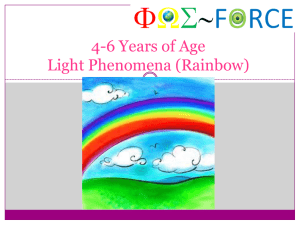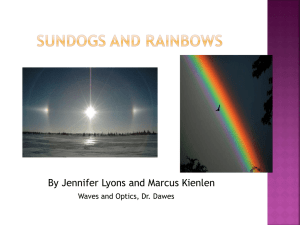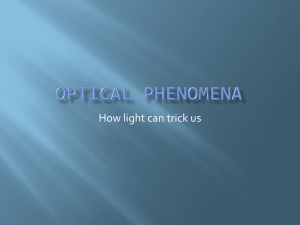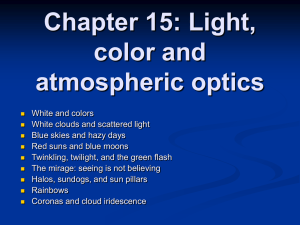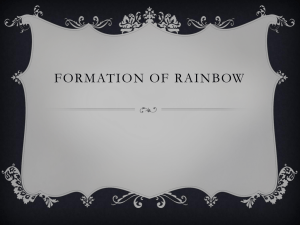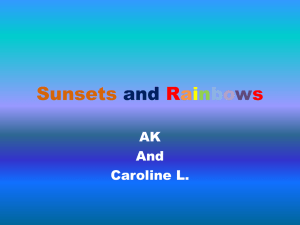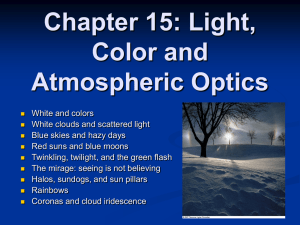Meteorology 125 Green Flash and other Atmospheric Optics
advertisement
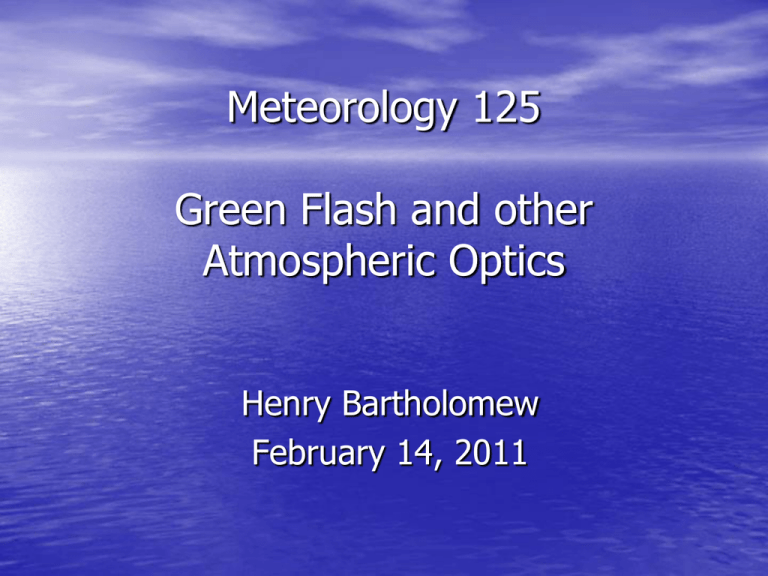
Meteorology 125 Green Flash and other Atmospheric Optics Henry Bartholomew February 14, 2011 Green Flash • What is the Green Flash? – An afterimage from staring at the sun? – A green spot that forms above the sun? – The top of the sun appearing green to our eyes? Green Flash Green Flash • The green flash is not an after image – It appears at both sunrise and sunset! Physics behind the green flash • As light from the sun travels into and through our atmosphere, refraction occurs • Apparent sunset occurs a few minutes after the sun has dipped below the horizon Physics behind the green flash • Refraction amount is dependent on wavelength – And therefore its… • COLOR • Blue light is refracted the most, red least • Highest red image + lowest blue image create white sun with top blue rim, bottom red rim Physics behind the green flash • When the sun is setting, eventually all wavelengths longer than green can be blocked – Only green visible • Green Flash mainly seen by observer • I-Mir (Inferior Mirage) Green Flash – Lasts 1-2 seconds – You might ask: Wait, what about blue? Blue light is shorter wavelength and refracts most, shouldn’t we see blue just prior to the sun completely dipping below the horizon? • Ideas? Why we don’t see a blue flash • Think about why the sky is blue… • Atmosphere scatters blue light more than any other wavelength (color) – Rayleigh Scattering • Under very clear conditions, however, blue flash can be seen! Blue Flash Green Flash • Best places to view – Clear view of the horizon • Ocean • Mountain tops Mock Mirage Green Flash Mock Mirage Green Flash • Piece of sun breaks off on top and is green for 1-2 seconds • Temperature inversion must be present, and observer must be above it – Doesn’t have to be large Other Green Flashes (Rarely seen) • Sub-duct flash – Observer below large inversion – Lasts up to 15 seconds! Sub-Duct Flash Green Ray • Green light spurts upward from sun • Lasts several seconds Green Flash over Golden Gate http://www.atoptics.co.uk/atoptics/gfvid1.htm Green flash over St. Kitts http://www.youtube.com/watch?v=jYkwmW0rGrM Rainbows • We have learned about primary and briefly, secondary rainbows – Is there a such thing as a triple rainbow? • Thoughts? • In order to discuss, we need to first review how a rainbow forms One possible explanation http://www.ebaumsworld.com/pictures/view/947432/ Colin McKellar Rainbow Formation • Light from the sun enters raindrop • Because water is different medium, light bends and therefore travels slower through drop • Different wavelengths refract different degrees • Light then reflects inside raindrop, exits and then refracts more Rainbow Formation http://svr225.stepx.com:3388/rainbow/file/69807.png http://www.rebeccapaton.net/rainbows/formatn.htm Secondary Rainbow Secondary Rainbow • Instead of reflecting once, light entering raindrop undergoes two reflections – Result • Colors are now flipped, so blue is on top and red is on bottom • Due to longer time in raindrop, there is more time of refraction, so colors are spread out over a greater area, and the rainbow is broader • Two reflections means more light is lost, as some travels through out of raindrop instead of being reflected – Reflection produces a rainbow with 43% brightness intensity of primary Broadening lowers surface intensity even more – hence, why we don’t see double rainbows more often Tertiary Rainbow • It is possible for light to be reflected 3 times inside of a droplet • The 3rd rainbow has about 24% brightness of primary bow – However, “triple rainbows” are almost impossible to see by observers • Numerous reasons why Triple Rainbow • First, instead of being opposite of the sun, it is on the same side! – Its light is overtaken by the 0th degree rainbow from the sun – basically, a glare of the sun through raindrops • Much broader, due to longer time in raindrop and hence more refraction and spreading out of colors – Less intensity per unit area Even Higher Orders • 4th order rainbow: Above 3rd order rainbow, with colors reversed – 15% intensity of primary rainbow • 5th and 6th order rainbows: On opposite side of sun – Much broader than lower order bows Higher Order Rainbows http://www.atoptics.co.uk/rainbows/orders.htm New topic • Look to the right of the title! Clouds • Tend to think clouds only occur in troposphere (except overshooting tops) • Actually, there are clouds that can not only form in the stratosphere, but even the mesosphere! • We’ll look at the lower ones first, called polar stratospheric clouds (PCS) – One type is nacreous clouds Nacreous clouds Very bright: Why? http://www.atoptics.co.uk/highsky/nacr1.htm Physics behind PCS • Form at very high altitude in the stratosphere, at heights of 15-25 km – Lower part – why? • Composed of ice crystals diameter 10 µm • Colors due to diffraction and interference • Form at temperatures below -78ºC (-108ºF) http://www.pahof.de/28457.html Two types of PCS • Nacreous, which form at temperatures below 85ºC • Type I: Less dramatic, slightly warmer (-78ºC) – Ia: Chemical compounds of H2O and nitric acid – Ib: Spherical droplets of nitric and sulphuric acid – Ic: Particles of metastable nitric acid - H2O Noctilucent Clouds • Literally, the highest clouds in our atmosphere • Form high in the mesosphere 80 km (50 miles) above the surface, 10 times as high as cirrus clouds! • Usually white and blue wispy streak • Extremely rare to see! Physics behind Noctilucent Clouds • Usually seen in polar regions during twilight, in summer months, and shortly before sunrise and after sunset – Why? • There is very little H2Ov at this level, but at extremely cold temperatures of probably around -160ºC (-256ºF!!), the tiny amount available can freeze onto nuclei – One possible supply is meteoric dust • There are still a lot of uncertainties behind these clouds, but they have increased over the past several years – Could be related to climate change Discussion of noctilucent clouds wouldn’t be complete without pictures! http://www.thelivingmoon.com/43ancients/02files/Noctilucent_Cloud_Images_01.html Noctilucent clouds http://www.atoptics.co.uk/highsky/nlc1.htm NASA video Interested in even more atmospheric optics? • There are numerous other features! • Circumzenithal arcs, circumhorizontal arcs, moonbows, coronas, supernumerary rainbows, aurora borealis/australis, and more! • Check out this awesome site – http://www.atoptics.co.uk/ Thanks for listening! • Any further questions?
